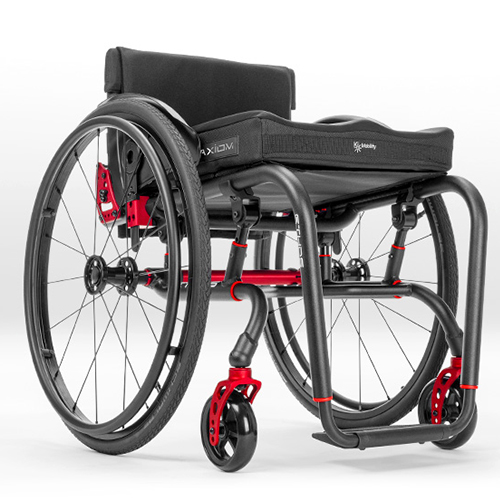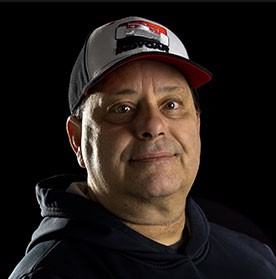
Meet the Designer Behind Ki Mobility's Ethos
11 September, 2020
Written by Ki Mobility
Tom Whelan, Vice President of Product Development at Ki Mobility, and Jacki Rettler, Product Manager for Ki Mobility sat down with the designer of the Ethos, Alan Ludovici, to learn a little about the person behind Ki Mobility's newest Ultra-Lightweight Wheelchair.
 Alan Ludovici - Senior Design Engineer for Ki Mobility
Alan Ludovici - Senior Design Engineer for Ki Mobility
"Where the needs of the world and your talents cross, there lies your vocation." - Aristotle.
JR: How long have you been a rider? A wheelchair designer?
AL: I've been riding for 35 yrs. and designing for 34 yrs. I had to think about that one.
JR: How many models of wheelchairs have you been involved in the design and development of? How many chairs have you designed for yourself over the years?
AL: I've designed about 27 or so that have been put into production. For myself, I've done somewhere between 70 and 80 chairs.
JR: Through all of those designs what influenced you the most?
AL: I grew up racing and eventually designing and building go-carts. As simple as they are the biggest thing to get them to work well is weight transfer. Throughout my years of racing, I learned a lot about weight transfer. I also worked with bicycles at Cannondale for a number of years. A lot of the technology I've designed into wheelchairs comes from what I have learned from racing and designing go-carts and bicycles. How I put tubes in certain places and little details in the design are all done to make the chair roll really well.
JR: What about the Ethos frame design is different and what does that mean to the rider?
AL: The biggest thing about the performance of a chair is what touches the ground needs to be rigid, so it doesn't lose energy. This is why the Ethos bottom frame is so rigid. But, I also used a small cross brace upfront which allows for some flexion in the caster, this makes the chair ride really well. When we did the rolling road test you could actually see the design working. To get the vibration out I isolated the seat frame from the base frame. Being separate from the base, the seat frame and the weight of the seat frame becomes part of your body, not part of what you are pushing. The worst thing about propelling a wheelchair (he laughs) is being on top of the vehicle you are propelling. There's a big difference in being performance-oriented and focusing on efficiency.
AL: Also, because the seat frame is isolated you have a huge improvement of ride quality without a loss of performance. My back is hypersensitive. When I experience light touch on my lower back it causes me a lot of pain. Anyone with neurological injuries probably knows what I am talking about. Vibrations I get from rolling over rough surfaces is very painful.I hate riding over them, for that reason I will avoid them. Ethos cuts out almost all of that. It doesn’t go into my body anymore so I don't experience that pain.
JR: From your perspective is this what makes Ethos so unique?
AL: In all seriousness, the funny thing about it is that I never thought I would be able to design something better than chairs I designed in the past. Is this on the record or off the record (he laughs)? I believe the Ethos is one step above. The ability to balance weight, the perfect amount of flexion in the front with an incredibly stiff rear. It's truly a better product. We as a company aren't just designing chairs to compete with the status quo. It's just not like anything else out there. Did that answer the question?
JR: I think so.
JR: Assuming in your spare time you don't just build wheelchairs what else do you like to do?
AL: I just love to build things. I build robots, I build mini machines and I have a few 3d printers. I make cute things for some people that I like…sometimes. TW: That implies there are people you like. AL: I sent my mom a buddha that I made for her. TW: You're from back east so of course, you like your mother.
AL: For the most part I do a lot of hands-on mechanical things. As I've gotten older and had some injuries I do smaller things than what I use to. I built full-blown CNC machines from the ground up when they first came out. Now I just make a mini one at home. (laughing). I like to be creative. I designed a starfighter this week that I am printing out on my 3D printer.
JR: That’s cool.
AL: But when the weathers nice I do like to get down to the river and wheel around for exercise. I really like going to the race track. That's a big deal.
JR: You mentioned the race track. I imagine you probably have a favourite race car driver?
AL: Of all time, Mario Andretti.
TW: I didn't know that we share that.
AL: I actually raced against his kids back in the day.
TW: What's your favourite circuit?
AL: That I've driven on or as a general statement?
TW: Both.
AL: Driving wise Watkins Glen or Bryer Motorsports Park which is now the New Hampshire Motor Speedway was really quite a fun track with hills and corner changes. I actually like watching short track races the most, even with Indy cars. Something like Milwaukee Mile or the Iowa 300 which last year was an insane race. There were something like 300 passes in the race which is unheard of for an open-wheel car race. It was a really amazing race.
TW: What's your favourite class?
AL: Indy car is probably the supreme. Then sprint cars and super modifieds. All which are crazy fast. World of Outlaws is probably the best show you will ever watch.
TW: What's your favourite race movie?
AL: Le Mans. I think it spearheaded my life. I even have Gulf Porsche glasses.
JR: Do you have any recommendations to fellow riders when it comes to selecting their next chair?
AL: Can I preface it?
JR: Of course.
AL: When I was first injured I had 8 weeks to figure out how to do wheelies and some other skill sets but I still changed post-rehab. Today people have a lot less time. The first 2 years after my injury I changed so much. The best thing to do is to get good skills and get the chair balanced well for you. You sometimes joke about my CG being so far forward.I use to be even further forward. I could tip my head back and pop a wheelie. I had an amazing sense of balance. Things change. So I think having the ability to make changes to your chair as you change or your life changes is really important. I am still continuously making adjustments. No matter what you are riding on and no matter how much it weighs, 50lbs or 20lbs, if it’s a rigid frame or a folder; if its balanced well to your body and your abilities it will make your ride so much more efficient. It will also put less wear and tear on your body. Wait until I tell you about the next product I have in mind. (Smirking)
JR: Thank you Al.
Originally published by Ki Mobility
Click here to view the Ki Mobility Ethos
